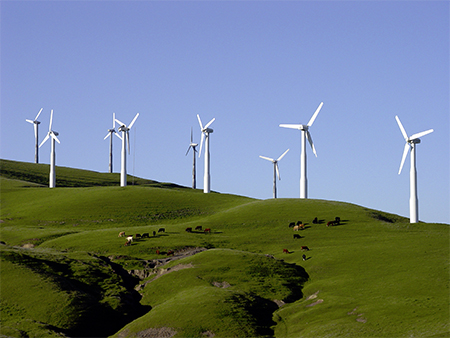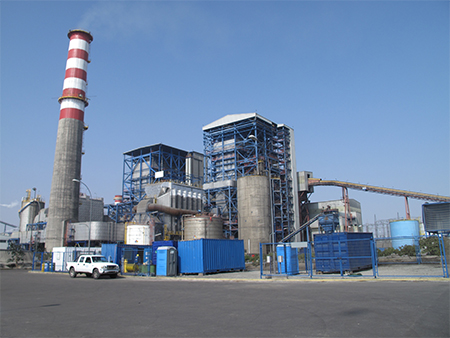
Providing a Reliable Solution for Modeling Large Industrial Facilities
Feb 20, 2013
Editor's Note: Modeling industrial facilities—which exhibit a great number and array of assets—is challenging. This article features an in-depth look at that approach for the largest, most complex industrial sites, and includes a case study highlighting the utility of AIR’s 400-series of occupancy codes, meticulously designed for these particular exposures.
A Priority Emerges: Disaster Defense at Industrial Sites
Recent large catastrophes such as the Tohoku earthquake in Japan, the floods that devastated parts of Thailand, and Hurricane Sandy along the U.S. East Coast produced billions of dollars in insured loss to industrial facilities. Risk managers, governments, and a wide variety of other stakeholders exposed to catastrophe risk are taking note of the need to enhance disaster defense at such sites.
In Japan, for example, more than 80 industrial complexes built in the 1950s and 1960s (a period of high economic growth) have been identified as never having undergone disaster mitigation measures. The government is conducting an earthquake resistance survey at many of these facilities. If safety problems are discovered, companies operating at these sites may be required to implement physical risk mitigation measures to protect against earthquake and tsunami damage.
As industrial facilities continue to be constructed in areas of high hazard and as older ones age, those responsible for assessing and mitigating the risk face a challenging task.
A Pipe Rack Is Not a Building
Industrial facilities are unique in that they exhibit not only a large number, but a wide variety of distinct components. These may include tanks, flares, cooling towers, transmission systems, and transportation assets.
Critically, unlike most commercial structures, the components that comprise industrial facilities are not always inside building walls. This is especially true for large industrial sites, where assets like tanks and pipe racks are located in open areas, completely apart from building structures. These kinds of components also behave quite differently from buildings when subjected to natural hazards. Furthermore, they behave quite differently from one another; at a particular wind speed, for example, flares and cooling towers may sustain significant damage while pumps and transformers remain practically unscathed.
Traditional vulnerability assessment methods treat an industrial facility as a single entity or, at best, a collection of industrial buildings. And the components, no matter how diverse, are treated as building structures or contents. The facility’s predominant construction type is used to characterize its vulnerability, but in reality, occupancy is a better proxy because industrial facilities of the same occupancy typically exhibit similar component breakdowns.
Recognizing the need for a more detailed solution to modeling large industrial facilities, AIR introduced a radically new approach in 2009.1 This component-level approach assesses the overall damageability of a facility based on the damageability of its components and sub-components, the presence and relative numbers of which are largely determined by a facility’s purpose, or occupancy.
AIR’s novel methodology for estimating damage and loss was made possible by the work of its Catastrophe Risk Engineering (CRE) team. For more than four years, our CRE engineers have conducted site-specific engineering-based risk assessments that provide an unparalleled level of insight into the distribution of industrial assets by plant type for common facility types the world over. Based on these investigations, AIR engineers have identified over 550 distinct components and subcomponents and have created more than 400 representative component-level damage functions.2
This body of work was used to design a new series of industrial facility codes, the 400-series, in AIR’s Touchstone™ and CLASIC/2™, and CATStation® applications, that can be used to assess the vulnerability to earthquake ground-shaking, wind, and storm surge of over 60 different large industrial facility types, including pharmaceutical plants, petrochemical facilities, and auto manufacturers. These codes are tailored to large industrial facilities and thus reduce the uncertainty in the vulnerability assessment. AIR’s approach gives companies a more detailed view of their risk—whether for single facilities or for large portfolios comprising diverse sets of facility types. No other approach combines catastrophe modeling and engineering-based component-level analysis in this way.
Note that AIR’s pre-existing methodology for modeling less complex industrial facilities remains available through the 300-series codes. These are useful for small facilities that, unlike their larger counterparts, enclose equipment mostly inside building walls.
New Developments: Assessing the Risk to Renewable Energy Facilities
Since AIR first introduced its component-based approach to modeling the vulnerability of industrial facilities, AIR engineers have continued to study the breakdown of components in different facility types worldwide. Such ongoing research is essential because new component classes continue to emerge over time.
Assets unique to renewable energy facilities, like the wind and solar farms, increasingly dot the landscape. Significantly, these industries are expanding in areas characterized by moderate to high earthquake and wind hazards. Consequently, a thorough understanding of renewable energy asset vulnerability is critical to managing and mitigating the natural catastrophe risk associated with this fast-growth industry.
AIR’s in-depth engineering studies of renewable energy infrastructure, such as wind turbines and solar panels, show that the performance, or damageability, of such systems is highly sensitive to a multitude of site- and asset-specific details. This makes it difficult to assess their risk using broadly categorized approaches typically found in risk models. AIR’s CRE engineers have taken a more rigorous engineering-based approach.

The Details Matter: A Case Study
Accurate risk assessment of large industrial facilities is highly sensitive to the information model users enter about facility composition. It is also important to account for critical mitigation efforts, like the anchoring of components.
Stakeholders, like commercial underwriters, can obtain facility-specific information by inspecting the sites and noting the components and purpose of the facility. They can then translate this information into the most appropriate occupancy code in AIR’s 400-series. Note that these codes reflect differences in vulnerability by region. For example, energy facilities along the U.S. Gulf Coast typically exhibit mitigation efforts, like raised control panels, more consistently than those in other parts of the United States. AIR’s 400-series damage functions capture this variation.
To demonstrate the utility of the 400-series, the following example shows the differences in loss that can result from coding such exposure with the 300-series instead.
A power plant located in the United States produces electricity by burning fossil fuels, such as coal or oil. It is less than five miles from several active faults, and thus at risk from hazards including earthquake-induced ground shaking, liquefaction, and tsunami. Some components, like conveyor systems, piping, and flares, would be relatively vulnerable to moderate earthquake-induced ground shaking, while others, like open frame structures and turbines, are not.
After assessing the facility’s many buildings and other components, many of which are located in the open, the underwriter decides to code the facility as a thermo-electric power system (code 477). Choosing the 400 series results in a more detailed assessment and because the damage function for facility type 477 is a composite of component-level damage functions for elements like flares and conveyor systems—each one weighted according to the share it constitutes of a typical thermo-electric power plant’s total replacement value.

If the 300-series were used instead, the best matched occupancy code would be electric (code 361), which would be appropriate for a small electrical station. In this modeling scenario, the thermo-electric facility’s total insured value—including the many structures and the diverse components—would be treated as buildings and/or contents instead of as uniquely vulnerable assets.
AIR examined the impact on the modeled average annual loss (AAL) of using the 300-series versus the 400-series. Results show that the average annual loss for the site (with a USD 230 million replacement value) decreases by nearly 37% when using the 477 code (Table 1). The 100-year return period loss decreases by 44%. Note that using the 400 series does not always result in lower loss values, but rather a more accurate estimation of the risk.
| AIR Occupancy Code | Average Annual Loss (USD) | 1% Exceedance Probability Loss (USD) |
|---|---|---|
| 361 | 68,495 | 842,940 |
| 477 | 43,479 | 469,708 |
There are significant advantages to using the 400-series from a risk management and mitigation standpoint. Commercial underwriters can take full advantage of the detailed risk information they collect when inspecting the facilities they underwrite. They can be sure the information they have meticulously gathered is assigned the facility code that best represents the relevant component-level vulnerabilities. The process of translating the information about a facility’s constituent components to a particular facility code also helps commercial underwriters better visualize and understand their exposure data.
Portfolio managers can also benefit from using the 400-series. These executives are tasked with pursuing business objectives while balancing risk and return, decision-making that requires them to be highly informed. They must closely evaluate how the diverse set of facility types they manage fits in with their entire portfolio. The increased accuracy achieved with the 400-series can help them better understand when potential losses to a single risk warrant pursuit of mitigation options—either through insurance purchase or physical improvements to critical components. By enhancing portfolio managers’ risk views through comprehensive results, AIR’s 400-series ensures that they are in the best position to make fiscally responsible risk management decisions. Brokers, meanwhile, can use results from the 400-series analysis to enhance their roles as trusted advisors.
Concluding Remarks
Informed decisions are an integral component of any sound risk management program, and the 400-series provides a more accurate and objective assessment of vulnerability for stakeholders throughout the risk management chain. AIR recommends that companies with portfolios of high-value industrial facilities investigate their key loss-driving risks and use the 400-series to assess potential damage and loss. AIR’s detailed modeling capability for these facilities is currently available for the United States, Japan, India, the Caribbean, and Australia and will soon be available for additional models.
Before the introduction of AIR’s 400-series, commercial insurers that wanted to assess the potential damage and loss to large industrial facilities were not able to derive the maximum benefit from catastrophe models. Critical information about the default breakdown of components was nowhere to be found, and as a result, there was high uncertainty in the estimates of damage and loss to complex, high-value industrial complexes.
Since 2009, however, that has changed. AIR’s industry-leading efforts to increase accuracy of catastrophe loss assessments have extended to the commercial space. Users can leverage AIR’s detailed modeling software to represent large and complex industrial facilities and to achieve more accurate loss estimates, which in turn help make better risk transfer decisions.
1At that time, this capability was just available for the AIR Model for U.S. Earthquake.
2 These damage functions are available in the hurricane and earthquake models for the U.S., the earthquake and typhoon models for Japan, the earthquake and tropical cyclone models for Australia, and the tropical cyclone models for the Caribbean and India.

